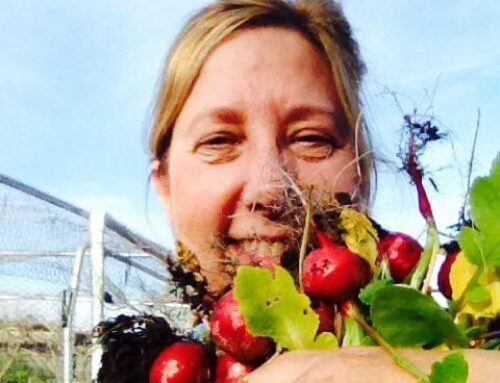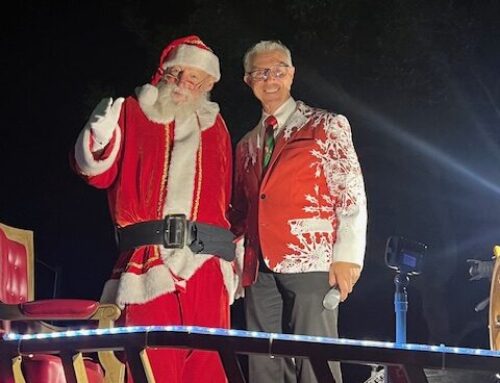Published May 4, 2016 on the Morgan Hill Life website
CLICK HERE TO READ STUDY ONLINE
By Staff Report

A bobcat travels along fisher Creek in San Jose.
Photo from Wildlife Cam Courtesy of Pathways for Wildlife
Wildlife habitat in the Santa Clara County region is becoming fragmented due to construction of roads, housing and other types of buildings and this is putting wildlife such as mountain lion, bobcat, badger and coyote at risk of becoming geographically isolated and eventually dying out, according to a report released May 4.
The Santa Clara Valley Open Space Authority, Guadalupe-Coyote Resource Conservation District, and the California Department of Fish and Wildlife have released the Coyote Valley Linkage Assessment Study that documents the wildlife species moving across the Coyote Valley floor between the Santa Cruz Mountains and the Diablo Range. Located between the rapidly growing cities of San Jose and Morgan Hill, the floor of Coyote Valley is one of only two remaining land linkages in the South Bay connecting these mountain ranges and allowing for wildlife passage.
“These wildlife species depend on large landscapes to maintain healthy populations. The findings of the study confirm the importance of Coyote Valley to wildlife movement and inform actions that must be taken to prevent local extinction of these species and ensure their viability,” said Galli Basson, resource management specialist at the Open Space Authority.
The issue of habitat destruction and fragmentation in Santa Clara County mirrors a global phenomenon that is impacting species all over the world. According to the Center for Biological Diversity, scientists estimate Earth is now losing species at thousands of times the natural rate, with as many as 30 percent to 50 percent of all species heading toward extinction by mid-century. CBD stated that ninety-nine percent of currently threatened species are at grave risk due to habitat loss, invasive species, and climate change impacts – all caused by human activities.
The Center for Biological Diversity contends that most benefits of biodiversity occur at a local level, and conserving local populations is the only way to ensure the genetic diversity that is critical for a species’ long-term survival. Healthy wildlife populations comprise a natural community of multiple, interdependent species, that includes plants, trees, animals, insects, fish and amphibians. This biodiversity helps ensure the resilience of ecosystems, upon which all human communities depend.
Using wildlife cameras, computer modeling, and peer-reviewed scientific studies (Critical Linkages: Bay Area and Beyond 2013, Bay Area Critical Linkages Project, and the Santa Cruz Mountains Linkages Project), the study confirms that Coyote Valley is a critical linkage between the Santa Cruz Mountains and the Diablo Range, both of which have large undeveloped tracts of habitat for wildlife that require large areas to roam.
“The purpose of the Coyote Valley Linkage Assessment study was to identify active wildlife pathways across the valley floor,” said Tanya Diamond, wildlife ecologist and co-principal of Pathways for Wildlife, who conducted the study. “We set up cameras to document wildlife movement and found that deer, bobcats, coyotes, gray fox, and skunks are consistently moving throughout the valley floor on a regular basis. Another component of the study is collection of scat and hair for genetic sampling to determine if genetic flow or isolation is occurring for two study species — the bobcat and ground squirrel.”
The cameras documented several pathways that animals are using to travel between the Santa Cruz Mountain foothills across the Coyote Valley floor, to Coyote Ridge and the Diablo Range on the east side of Highway 101. Both large and small animals including bobcat, deer, coyote, gray fox, raccoon, and ground squirrels were sighted along the creek systems, which indicates that both Fisher and Coyote Creeks serve as important linkages. Cameras also recorded bobcats traveling from central to northern Coyote Valley with the potential to reach Coyote Ridge from below Highway 101 through several tunnels, or culverts.
The study’s findings also showed the presence of juvenile deer, coyote and bobcat traveling with their parents. This finding highlights the significance of Coyote Valley as critical habitat in that it provides food and water resources, breeding and birthing habitat and also allows the young offspring to establish their own ranges.
The study identified physical barriers to wildlife passage present at six sites within the study area. These barriers include fencing at several locations and culverts that are filled with debris or blocked by concrete slabs which restrict or prevent wildlife movement and passage. Several areas with high instances of roadkill were found to correlate with these blocked culverts and fencing.
The Coyote Valley Linkages Assessment study concludes that the Coyote Valley floor is an essential travel route for a variety of wildlife species, ranging from small to large mammals. With the goal of preserving and enhancing Coyote Valley as a critical wildlife linkage, the report supports the following recommendations:
· Remove barriers including fences and blocked culverts to allow safe passage for wildlife
· Maintain the habitat values and characteristics on Coyote Valley lands for compatibility with wildlife movement
· Work with the high speed rail authority to ensure that future rail alignments and crossing structures are coordinated with crossing structures on Hwy 101
· Maintain agricultural land uses wherever possible instead of industrial use of Coyote Valley
The recommendations of the Linkage Assessment Study will inform state, regional and local land use planning, development projects and restoration efforts.
“The work being done in the Coyote Valley by Pathways for Wildlife is critical for mapping, preserving and enhancing the connectivity corridors across the Coyote Valley floor,” said Bill Leikam, member of the board of directors for the Guadalupe-Coyote Resource Conservation District. “Safe passage for wildlife is essential to the health of the land and of the wildlife living in the greater region between San Jose and Gilroy.”







